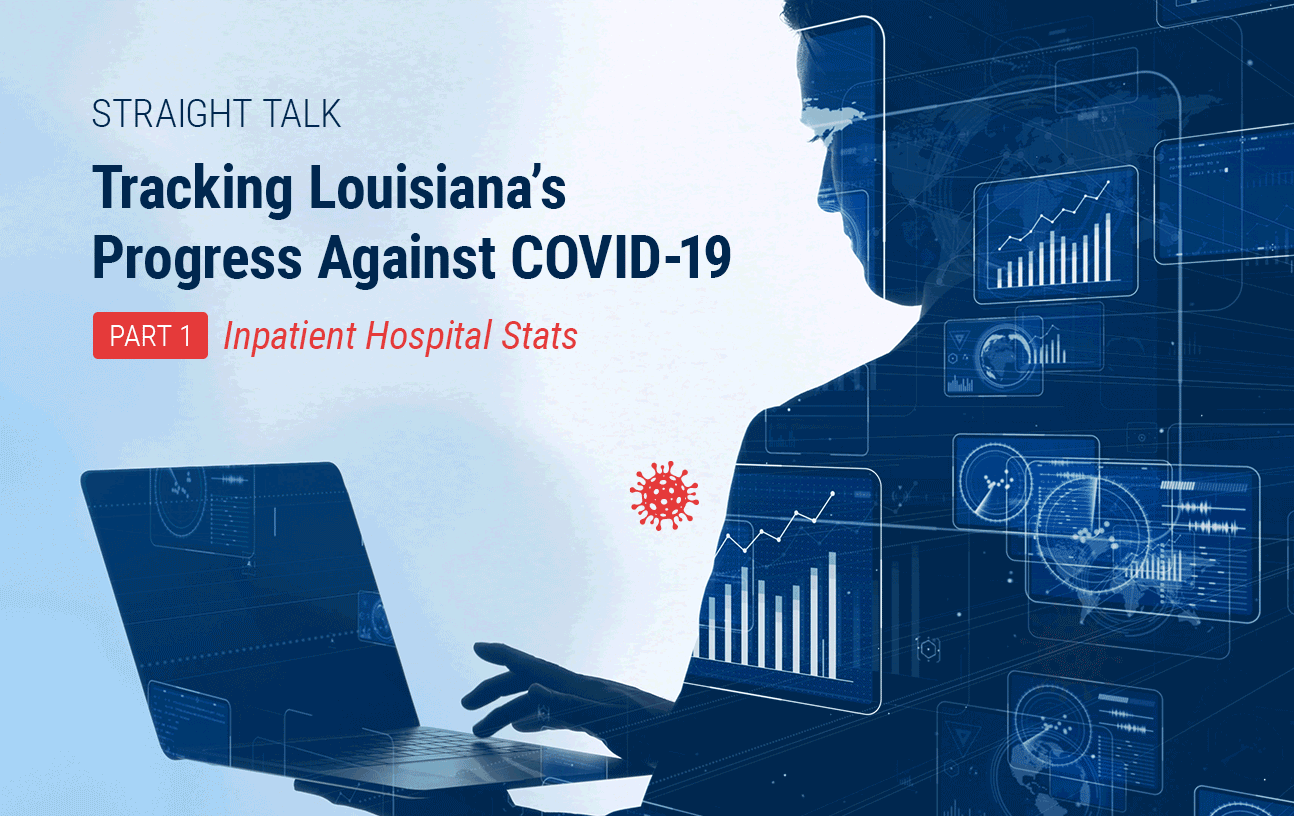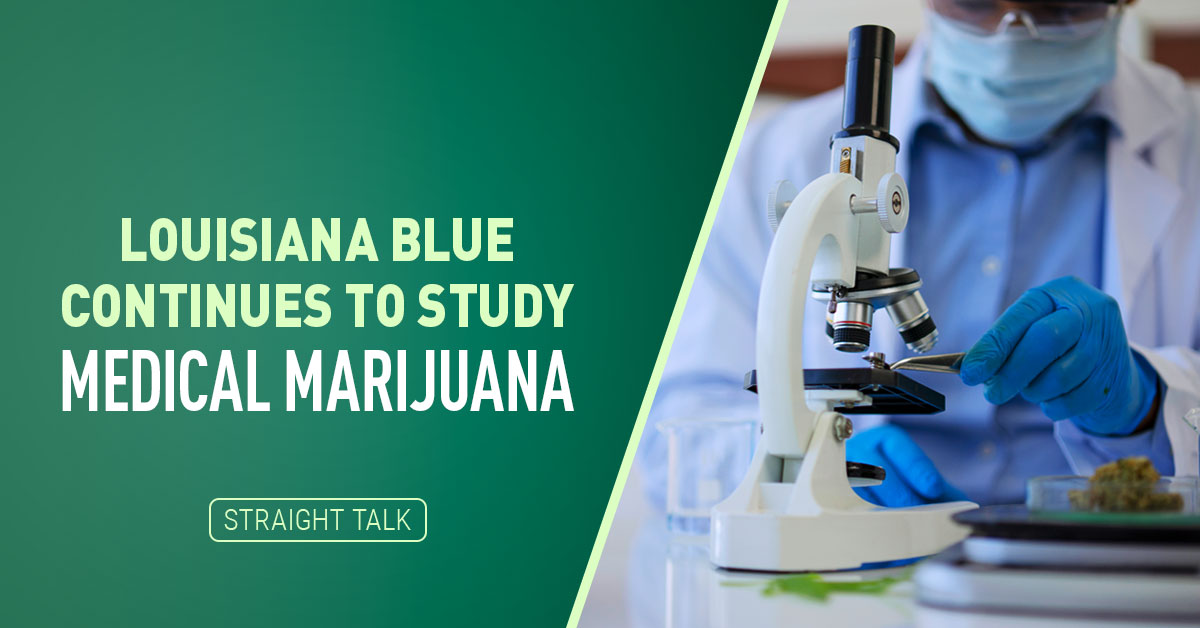In the data world, we always have options. Sometimes, way too many options.
As COVID-19 took hold here in March, and we began to see just how serious it was going to be, it became clear that finding strong, reliable data that was EASY TO COMMUNICATE to everyone was going to be a challenge.
After watching some data sources and results get shot down by naysayers, and knowing how important it was going to be to our economic success that the data I presented here via Straight Talk was reliable AND believable, I settled on three main areas of data that I want to track and communicate to you all. I believe these points are strong indicators of how close we are getting to Phase 3. In this post, we will tackle the first one: How many people are COVID-positive and in the hospital?
Whatever data sources and variables I choose to display have to be meaningful indicators of how we are doing and how we are trending toward getting our economy back open. With 300,000 and 400,000 Louisianians out of work right now, and federal benefits for unemployment shut down, I believe these are critical numbers.
And by the way, Phase 3 has just become a catchphrase for when we can move our lives somewhat back to normal. It doesn’t necessarily mean you can stop wearing masks or social distancing or paying special attention to hand hygiene, it simply means a situation where, economically,we can start moving back to normal. You can think of our pre-COVID life as Phase 4-ish. We are currently stuck in Phase 2, where we have targeted closures, recommendations against unnecessary travel and mandatory mask orders in place.
How Many People With COVID-19 Are Sick Enough to Be in The Hospital?
I have found the “people with COVID in the hospital” number to be VERY useful as an indicator of how we are doing, both economically and health-wise. You can also tell from this data when things got better or worse, and when changes, like the Governor’s statewide mask order, began working.
Here’s the current “people in the hospital with COVID-19” graph:
First, let’s talk a bit about that title. Note it says, “7-Day Moving Average.” That’s just a fancy way of saying that each little bit of data, each point on this graph, is the average of that day plus the six days that came before that day.
We use moving averages to smooth out graphs and let actual trends that we want to see and understand pop out. It also means each point of data is much more important than it would be on its own. You can see clearly in this graph, for example, when things got better, and when they got worse, and when they got better again. Using the averages pushes that underlying trend out where we can see it.
Masks, Social Distancing and Healthy Habits Are Working
Like all good data trends, this one tells an important story about our fight with COVID-19. This data begins with a reading of people who were in the hospital as of May 7, just a few months ago. In the timeframe just prior to when this graph started, our COVID-19 hospitalized patients peaked in mid-April, at 2,100 people. For weeks afterward, the number of people in the hospital declined all the way through the shutdown to mid-June, when we had reduced that original number by 75% (to the 550s)!
Then we moved to Phase 2, which, in my opinion, some people took too liberally. You can see where that got us through the end of June and early July. This quick rise in cases prompted the Governor to issue his mandatory mask order and close down bars on July 13.
Almost exactly two weeks into the new orders, hospital cases peaked (on July 28) and have been going down ever since (exactly as predicted would happen).
The good news is, after a month of masking-up, hospitalizations are trending in the right direction, although if your eyes are sharp, you will notice that the decline is not nearly as fast, or as steep, as the decline in May and June.
There are a variety of reasons why that is, but we know that there are a LOT more people with COVID-19 in the general population now, and not everyone is on board with bar closings and masking up just yet. These factors combine to mean that reducing the number of more serious COVID-19 cases in the general population is just going to take a bit longer this time. So, we have to be patient and keep following the rules.
Since a significant percentage of the people who get COVID-19 die from it, typically within 15-16 days AFTER they are admitted to a hospital, here is clear evidence that lives are being saved by our sacrifices when we change our behavior and wear face coverings. GOOD JOB!!
Why We Track Patients on Ventilators
Finally, I want to point out the little red line on the graph, the one that is labeled “% on Ventilators.” COVID-19 often kills patients by damaging their lungs so severely that they can no longer breath on their own. When that happens, the patient is at a very late stage in the disease, and their likelihood of dying jumps up. This line represents the percentage of people in the hospital with COVID-19 who require this mechanical breathing help. I believe it is an indicator of how serious the cases of COVID-19 are for people that remain in the hospital.
Also, when people are on a ventilator, they are typically in an intensive care unit bed instead of a regular hospital bed, so it helps to show how these scarce healthcare resources are being used. The gentle rise in that graph makes sense because less-serious cases are getting well and there are fewer of them, but the more serious cases are sticky. There are still quite a few people in the hospital, and they stay much longer. As of this week, around 15% of those hospitalized are so sick they require this mechanical breathing assistance.
We Need to Keep Slowing the Spread
Everywhere I go, people I speak to, I run across people who are data skeptics and think COVID-19 and our reactions to the virus are way out of proportion. I’ve even had people tell me, “Mike, the whole thing is a hoax, I don’t believe it!”
This makes me sad, but I know there are plenty of people out there who are not sick, who feel fine, and are still taking an economic beating by the job losses, low oil prices and shutdowns. I know what it’s like to not know what to do when your job ends. It’s the worst feeling.
But, let me say this:
COVID-19 is real, dangerous to a significant part of our population, and figuring out how to stop it from spreading and killing people is critical to our economic recovery. There is no “Phase 3” or “Phase 4” until we can prove our COVID-19 trends are heading in the right direction, and we can KEEP them headed in the right direction. This requires us ALL to be inconvenienced a bit for a while.
Straight Talk Is, Masks = Jobs.
Not right away, and not all at once, but until there is a vaccine, this is our best line of defense.
Soon, we’ll look at two other data types I find critical to tracking our progress vs. COVID-19: The daily rate of people dying from the disease, and factors that tell us how it is spreading.
Until then, #MaskUp, wash your hands, keep your distance (six feet at least) and avoid crowds whenever you can. I can’t afford to lose any of you.





You are all for one method of treatment. Where viruses have been with us since the beginning of time and will be with us until time ends, you need to also include other sources of information. Inflammation of any body part will cause a promblem, this one is upper respiratory. Why can’t you also talk about treatements where doctors have successfully treated their patients with anti-inflammatory procedures. Yes, we do take this serious, we take all illnesses serious, let us also take into account procedures that have worked and continue to work other than masking, social distancing, and measures that never include success doctors are having. I suspect that any vaccine will be just like vaccine, flu etc, people still die and will continue to die. I will never minimize the importance of illness and death, however if you do the math globally, nationally, statewide, and city, the numbers are less than 1% for death. I was just listening to a program with a cardiologist, who said all of the present 19 concerns have caused many heart patients to neglect their present condition. I am so glad God is in control of life. He appoints our time and boundaries. He said “It is appointed once for man to die and then the judgement,” (Hebrews 9:27).
Janice!
I appreciate your thoughts. The treatments that are making a difference in some seriously ill Covid-19 patients (like Remdesivir and Dexamethasone) are not something you can give yourself at home, and must be carefully monitored to make sure they don’t cause more damage. While I am aware of many, many different drugs on the Internet (hydroxychloroquine, azithromycin, ivermectin, etc) that claim to protect people from Covid-19 or even cure it, there is no repeatable, reliable science that we can find anywhere that proves these drugs matterwhen you get sick, or keep you from getting sick. To avoid confusion, I don’t talk about them because I don’t want to contribute to the amount of bad data and noise already out there. If any drug really works, I suspect people will shout it from the rooftops (Including me!).
Believe me, I speak to and know people who are caring for very sick Covid-19 patients right now and if ANY of these treatments you are reading about could be proven to make a difference, they would be ALL over them! The sad reality is, at this point in time, for the average person, the absolute best defenses against Covid-19 are exactly the things we’ve been saying all along: covering your mouth and nose in public, social distancing of at least 6 feet, washing your hands frequently, and avoiding touching your face. And looking forward mightily to a vaccine.
I just want to make sure the information we talk about here at Straight Talk has solid, repeatable science behind it. I hope that standards works for everyone.
And while I understand the argument that the 4,307 people who have died from Covid-19 so far this year might be “less than 1% death” to use your words, I will continue to honor those 4,000 plus people as Louisiana friends, neighbors, brothers, sisters, Moms and Dads and take their deaths VERY seriously. That also means doing everything I can to shut that number down and keep myself from catching Covid-19 or spreading it to anyone else.
You bring up another important point: NO ONE should be missing Doctor’s appointments because of Covid 19. I’ve made all mine, and I felt safer at the Doctor’s office than just about anywhere, they are doing a magnificent job of keeping their patient’s SAFE!
Thanks for reading! God bless you and your family, and Stay Safe!….mrb